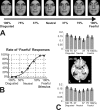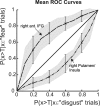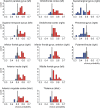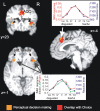Neural correlates of perceptual choice and decision making during fear-disgust discrimination
- PMID: 17360913
- PMCID: PMC6672587
- DOI: 10.1523/JNEUROSCI.3024-06.2007
Neural correlates of perceptual choice and decision making during fear-disgust discrimination
Abstract
In the present study, we tested the hypothesis that brain activation would reflect perceptual choices. To probe this question, we used functional magnetic resonance imaging (fMRI) during a challenging fear-disgust, two-choice discrimination task. We investigated how moment-to-moment fluctuations in fMRI signals were correlated with perceptual choice by computing a choice probability index that quantified how well behavioral choice could be predicted by single-trial fMRI amplitude. Our analyses revealed that reporting a neutral face as "fearful" was associated with activation in a broad network of brain regions that process emotionally arousing stimuli, whereas reporting a neutral face as "disgusted" was associated with activation in a focused set of sites that included the putamen and anterior insula. Responses predictive of perceptual reports were not only observed at the group level but also at the single-subject level. Thus, voxel-by-voxel fluctuations in fMRI amplitude for an individual participant could be used to reliably predict the perceptual choice of individual trials for that subject. In addition to the investigation of choice, we also isolated the neural correlates of decision making per se by using reaction time as an index of decision processes. Overall, our findings revealed that brain responses dynamically shifted according to perceptual choices. In addition, the neural correlates of decision making involved at least the anterior cingulate cortex, middle frontal gyrus, and inferior frontal gyrus/insula, consistent with recent proposals that decisions may emerge from distributed processes.
Figures





Comment in
-
Awfully afraid? Dissociating decision- from motor- and sensory-related brain activation during perceptual choices.J Neurosci. 2007 Jun 6;27(23):6081-2. doi: 10.1523/JNEUROSCI.1478-07.2007. J Neurosci. 2007. PMID: 17553980 Free PMC article. Review. No abstract available.
Similar articles
-
Quantitative prediction of perceptual decisions during near-threshold fear detection.Proc Natl Acad Sci U S A. 2005 Apr 12;102(15):5612-7. doi: 10.1073/pnas.0500566102. Epub 2005 Mar 30. Proc Natl Acad Sci U S A. 2005. PMID: 15800041 Free PMC article.
-
Decoding near-threshold perception of fear from distributed single-trial brain activation.Cereb Cortex. 2007 Mar;17(3):691-701. doi: 10.1093/cercor/bhk020. Epub 2006 Apr 20. Cereb Cortex. 2007. PMID: 16627856
-
Differential neural responses to overt and covert presentations of facial expressions of fear and disgust.Neuroimage. 2004 Apr;21(4):1484-96. doi: 10.1016/j.neuroimage.2003.12.013. Neuroimage. 2004. PMID: 15050573
-
[Neural mechanisms of decision making].Brain Nerve. 2008 Sep;60(9):1017-27. Brain Nerve. 2008. PMID: 18807936 Review. Japanese.
-
Neural correlates of decision processes: neural and mental chronometry.Curr Opin Neurobiol. 2003 Apr;13(2):182-6. doi: 10.1016/s0959-4388(03)00039-4. Curr Opin Neurobiol. 2003. PMID: 12744971 Review.
Cited by
-
Intrinsic Brain Network Biomarkers of Antidepressant Response: a Review.Curr Psychiatry Rep. 2019 Aug 13;21(9):87. doi: 10.1007/s11920-019-1072-6. Curr Psychiatry Rep. 2019. PMID: 31410661 Free PMC article. Review.
-
Graded representations of emotional expressions in the left superior temporal sulcus.Front Syst Neurosci. 2010 Mar 15;4:6. doi: 10.3389/fnsys.2010.00006. eCollection 2010. Front Syst Neurosci. 2010. PMID: 20305753 Free PMC article.
-
Can beneficial ends justify lying? Neural responses to the passive reception of lies and truth-telling with beneficial and harmful monetary outcomes.Soc Cogn Affect Neurosci. 2016 Mar;11(3):423-32. doi: 10.1093/scan/nsv127. Epub 2015 Oct 10. Soc Cogn Affect Neurosci. 2016. PMID: 26454816 Free PMC article.
-
EEG-fMRI based information theoretic characterization of the human perceptual decision system.PLoS One. 2012;7(4):e33896. doi: 10.1371/journal.pone.0033896. Epub 2012 Apr 2. PLoS One. 2012. PMID: 22485152 Free PMC article.
-
Evidence accumulation and the moment of recognition: dissociating perceptual recognition processes using fMRI.J Neurosci. 2007 Oct 31;27(44):11912-24. doi: 10.1523/JNEUROSCI.3522-07.2007. J Neurosci. 2007. PMID: 17978031 Free PMC article.
References
-
- Bar M, Tootell RB, Schacter DL, Greve DN, Fischl B, Mendola JD, Rosen BR, Dale AM. Cortical mechanisms specific to explicit visual object recognition. Neuron. 2001;29:529–535. - PubMed
-
- Binder JR, Liebenthal E, Possing ET, Medler DA, Ward BD. Neural correlates of sensory and decision processes in auditory object identification. Nat Neurosci. 2004;7:295–301. - PubMed
-
- Britten KH, Newsome WT, Shadlen MN, Celebrini S, Movshon JA. A relationship between behavioral choice and the visual responses of neurons in macaque MT. Vis Neurosci. 1996;13:87–100. - PubMed
-
- Bush G, Luu P, Posner MI. Cognitive and emotional influences in anterior cingulate cortex. Trends Cogn Sci. 2000;4:215–222. - PubMed
-
- Calder AJ, Lawrence AD, Young AW. Neuropsychology of fear and loathing. Nat Rev Neurosci. 2001;2:352–363. - PubMed
Publication types
MeSH terms
Grants and funding
LinkOut - more resources
Full Text Sources
